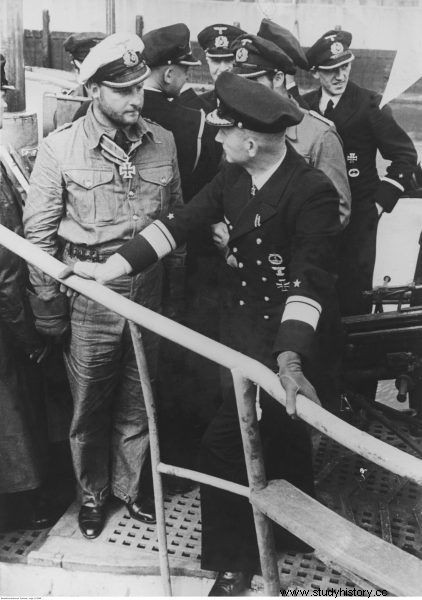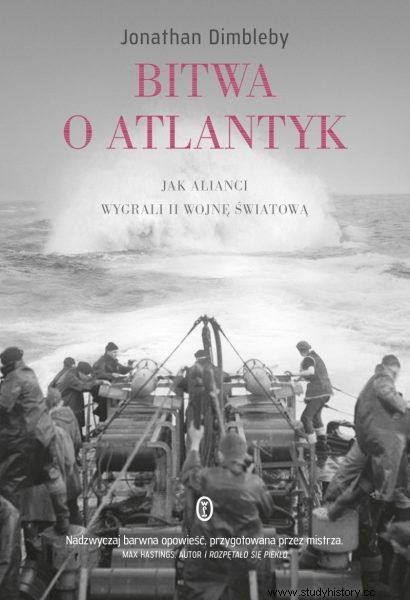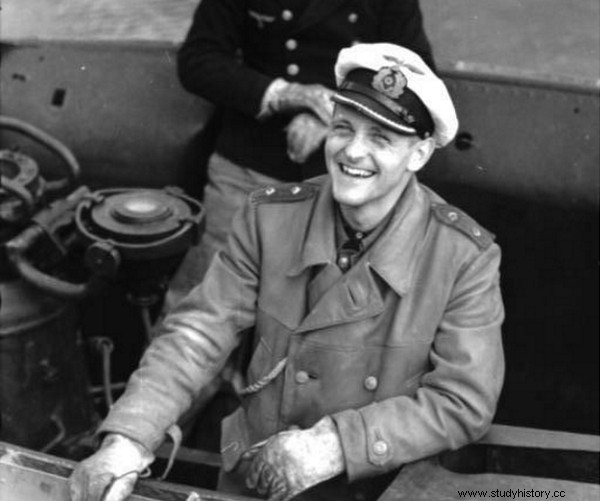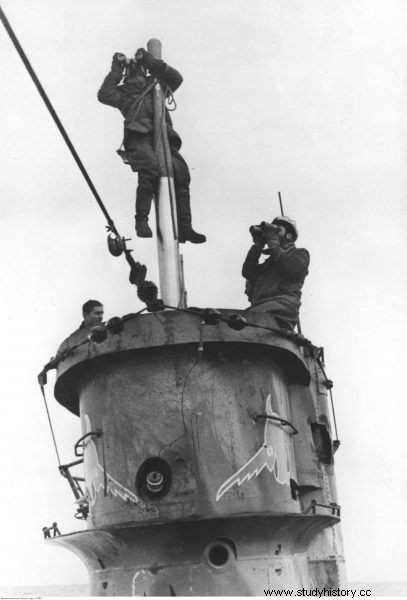They drowned passenger ships without warning. They shot the survivors. Nazi seamen from German U-boats committed a number of war crimes during the Second World War. And they avoided punishment for the most part.
"Athenia" - the first crime
German U-boats appeared on British communication routes even before the outbreak of the war. This was the case with the U-30, commanded by Captain Fritz Julius Lemp. On September 3, 1939, it was about 200 miles off the coast of Ireland. That day, in the evening, the Germans spotted a large ship. Without warning, they launched four torpedoes. One of them turned out to be fatal for the victim of the attack.
The hit vessel was the British passenger liner Athenia, running between Scotland and Canada. At that time, 1,417 people were on board, including women and children. Even though the ship's electricity failed after the attack, the British crew efficiently evacuated. The victims, however, could not be avoided. A total of 112 people were killed, including 69 women and 16 children.
Torpedoing a passenger ship without warning was a violation of the maritime law in force at that time. In addition, 28 Americans died on the ship, which could have caused the United States to enter the war. In order to avoid responsibility, the Germans undertook a violent propaganda action. They accused ... the British of the attack. As Jonathan Dimbleby writes in his book The Battle for the Atlantic. How the Allies won World War II ":
On September 5, Radio Berlin solemnly announced that if "Athenia" had indeed been torpedoed, "only an English submarine could do that." And it was added:"We believe that the current superior of the British Navy, Churchill, is even capable of such a crime" .

German Navy Captain Fritz - Julius Lemp (left) during a conversation with Rear Admiral Karl Dönitz (right).
The commanders and the crew of the U-30 were ordered to remain silent. The commander of the Kriegsmarine submarine weapons, Commander Karl Dönitz, even had the U-boat's logbook forged. However, this was done very carelessly. This document was one of the pieces of evidence against Germany during the Nuremberg trial. However, Fritz Julius Lemp did not stand before any military tribunal. Didin't make it. He died on May 9, 1941 in the North Atlantic, during a combat voyage on a new U-110 ship.
The drama "City of Benares"
On September 13, 1940, the British passenger ship "City of Benares" left the port of Liverpool. There were 90 children on board, among 407 passengers and crew members. They were to take refuge in Canada from the German air blitz.
At the beginning of the journey, the ship traveled in a small convoy, escorted by one destroyer and two gunboats. The escort turned back when the units left the area declared by the Germans a closed sea area, where they applied the principles of unlimited submarine warfare. Theoretically, outside this area, the "City of Benares" should be safe from unexpected attacks by German submarines.

The British, however, trusted too much German guarantees. September 18, around At 22.00 an unexpected explosion hit the liner. The ship, torpedoed by U-48 under the command of Captain Heinrich Bleichrodt, began to sink. Late hour, storm waves, squall and rain with hail made evacuation difficult. This is how Jonathan Dimbleby described the situation in his book "The Battle of the Atlantic":
There were shouts of terror as the boats were lowered into the rough sea. One of them rolled over as the screaming children fell into the water. The crew lowered the rafts and started throwing them lifebuoys, but none of the people on board saw either those who were thus saved or those who drowned.
In such difficult weather conditions, even the safe launch of the lifeboat did not guarantee rescue. The passengers also lacked warm clothing. As a result, adults and children died in the boats of exhaustion. Overall, the tragedy of the City of Benares claimed the lives of 258 people. There were 77 children among them .

Captain Heinrich Bleichrodt - it was the ship under his command that sank the City of Benares and the children traveling through it.
How was the attack on a defenseless ship presented by German propaganda? As with Athenia, Winston Churchill was blamed for the sinking of the ship. Later, the Germans maintained that they could not know who was on board the unit. This line of defense was adopted by Captain Bleichrodt, who stood before the Allied court after the war. The court accepted this explanation, and the U-48 commander never repented of causing the death of so many children. He died in 1977.
U-boat fire evacuation
German submarines were not limited to torpedoing the encountered units. Their shameful practice was firing cannons and machine guns at survivors evacuating from torpedoed ships. The crew of the British transport ship "Severn Leigh" was a victim of such behavior. On August 23, 1940, torpedoes launched by U-37 hit the ship, sailing south of Iceland. As the crew left the ship, the U-boat fired high-explosive shells at the ship. Sailors in lifeboats were also in the field of fire. Of the 43 crew members of the Severn Leigh, only 10 survived. Meanwhile, the U-boat commander, Lieutenant Commander Victor Oehrn, lived to a quiet old age. He died in 1997 at the age of 90.
A similar fate befell the American coal carrier "David H. Atwater". On March 2, 1942, it sailed from the Chesapeake Bay towards the Bay of Delaware. Unexpectedly, at around 9 p.m., he was fired upon by U-552. The submarine was commanded by one of U-bootwaffe's most famous aces, Erich Topp.

Erich Topp not only torpedoed Allied ships but also fired on lifeboats full of survivors.
The Germans maintained a murderous fire also when the crew tried to leave the ship torn apart by missiles. American patrol ships later encountered fire-pierced lifeboats containing the bodies of dead sailors. In the end, of the 27 men who made up the crew of the coal ship, only three survived. Erich Topp has never been held responsible. After the war, in West Germany, he continued to serve in the navy, reaching the rank of Rear Admiral. He died in 2005 at the age of 91.
The U-516, commanded by Lieutenant Commander Gerhard Wiebe, did not stop at sinking the enemy ship. On September 28, 1942, around four in the morning, he by surprise attacked the Brazilian ship "Antonico". The unit burst into flames under the shell of artillery shells. The crew managed to launch two lifeboats, but a German submarine opened fire on them. The survivors jumped out of one of the boats to take cover behind its hull from the bullets.
When the Antonico sank, the U-boat departed. Only then was it possible to assess the losses. It turned out that the second lifeboat also had holes in it. Inside there were 5 killed and 7 wounded sailors. A second officer on a Brazilian ship gave testimony against the German crew. Gerhard Wiebe was arrested after the war, but in 1947 he was released. He died in 1985.
Hunting for fishermen
German U-boats also attacked fishing vessels. The story behind the sinking of the British trawler "Noreen Mary" is particularly shocking. On July 5, 1944, approximately 20 miles west of Cape Wrath, a vessel was attacked by U-247 while it was catching fish.

U-boat commanders did not spare even the fishing boats. When they could not hit the small vessel with a torpedo, they surfaced and fired machine guns on the crew.
When two torpedoes fired at the trawler missed, the U-boat, commanded by Lieutenant Gerhard Matschulat, emerged and fired a machine gun fire on it. Six fishermen died on board. After the vessel was sunk, four others ended up in the water. U-247, however, did not depart. One of the fishermen recalled:
Even then, the submarine did not submerge, but was definitely walking in my direction, and when it was only 60-70 yards away, it opened fire at me with a short burst of fire. machine gun. As their intention was quite obvious to me, I slid into the water and stayed there until the submarine stopped firing and submerged (…). The submarine kept firing at us from its cannons for a full hour.
Eight fishermen were killed in the attack on the "Noreen Mary". Two survived. The memoirist, James MacAllister, had 14 wounds to the body. His companion, 48 U-247, did not live to see the end of the war. He was sunk on September 1, 1944 with the entire crew.
Slaughter in the Atlantic
The most famous crime at sea during the Second World War was the sinking of the Greek steamer "Peleus". On March 13, 1944, the ship was on its way from Freetown to Buenos Aires. About 600 miles off the coast of Africa, it was hit by two torpedoes. The steamer sank instantly. Some of its crew of 35 people ended up at sea. The perpetrator of the attack was U-852, commanded by Captain Heinz Eck. The submarine was on its way to its Indian Ocean patrol area.

U-852 surfaced and took two sailors aboard to interrogate them. They were later allowed to return to the life rafts. The U-boat has gone away, but not for long. After a while, he unexpectedly reappeared. His machine guns began firing at the terrified survivors in long bursts. The Germans were systematic:the massacre lasted several hours. There was one goal. No one was wanted to survive. It is worth adding that one of the victims of the sinking of "Peleus" was also a Pole, the smoker Wincenty Staniewicz.
Despite the prolonged shelling of the slaughter, three members of the Peleus' crew survived. Before they were rescued, they drifted in the ocean for over twenty days. Later they gave testimony against the Germans.
U-852 fell into the hands of the Allies. As it turned out, Heinz Eck did not destroy the ship's log which described the attack on Peleus. On October 17, 1945, the captain and his companions appeared before a tribunal. The commander and two officers, including the ship's doctor, were sentenced to death by shooting. Another officer was sentenced to life imprisonment, and one of the non-commissioned officers - 15 years in prison.

The U-boat commanders did not spare any of the ships they encountered on the seas.
Could it be otherwise?
The Allies were quite lenient towards the U-boat commanders after the war. Perhaps it was caused by the fact that their submitters also did not care too much about respecting the provisions of the maritime law. Under the conditions of total war, could submarines even conduct combat operations in a more humane manner? It turns out so. The best example of this is our ORP "Orzeł".
The most famous Polish submarine, commanded by Captain Jan Grudziński, in May 1940 torpedoed the German transport ship "Rio de Janeiro" off the coast of Norway. Before that happened, the "Orzel" emerged and the Polish commander ordered the Germans to stop and send the ship's commander with papers. When this did not work, the Polish ship warned the enemy unit: To leave the ship immediately. We torpedo within 5 minutes . It was only after that time that the Poles fired their deadly cigars, which finally sank "Rio de Janeiro".
Buy the book for a discount at Empik.com

